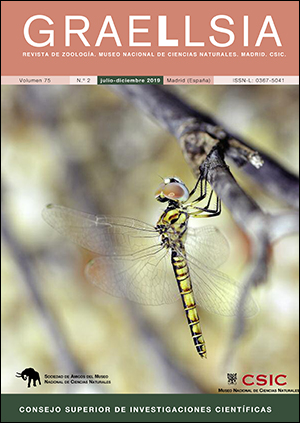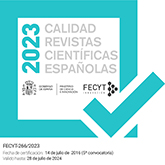Variación no alométrica en el cráneo del perezoso bayo Bradypus variegatus (Schinz, 1825) (Mammalia, Pilosa, Bradypodidae)
DOI:
https://doi.org/10.3989/graellsia.2019.v75.228Palabras clave:
alometría, Choloepus, perezoso de tres dedos, perezoso de dos dedos, XenarthraResumen
El perezoso bayo Bradypus variegatus (Schinz, 1825) es un mamífero monomórfico, de ontogenia craneal poco conocida. En este estudio analizamos la alometría estática entre tamaño y forma, utilizando 21 especímenes diferentes de edades diversas. El tamaño y la forma fueron determinados mediante técnicas de morfometría geométrica. De los resultados obtenidos se desprende que la variación en la forma craneal queda muy poco explicada por la variación en el tamaño. Muchos estudios han señalado características morfológicas únicas en los perezosos en relación al resto de mamíferos, características fenotípicas que van de la estructura esquelética a tejidos blandos. En este caso, el escalado no alométrico del cráneo debería ser visto como otra característica única de este grupo taxonómico.
Descargas
Citas
Adams, D. C., Rohlf, F. J. & Slice, D. E., 2013. A field comes of age: geometric morphometrics in the 21st century. Hystrix, 24(1): 7-14.
Bookstein, F. L., 1991. Morphometric Tools for Landmark Data. Geometry and Biology. Cambridge University Press. Cambridge. https://doi.org/10.1017/CBO9780511573064
Cartelle, C. & De Iuliis, G., 2006. Eremotherium Laurillardi (Lund) (Xenarthra, Megatheriidae), the Panamerican giant ground sloth: Taxonomic aspects of the ontogeny of skull and dentition. Journal of Systematic Palaeontology, 4(2): 199-209. https://doi.org/10.1017/S1477201905001781
Galliari, F. C. & Carlini, A. A., 2018. Xenarthran synsacrum morphology and evolution. Journal of Mammalian Evolution. https://doi.org/10.1007/s10914-018-9442-0
Hammer, Ø., Harper, D. A. T. & Ryan, P. D., 2001. PAST v. 2.17c. Palaeontologia Electronica, 4(1): 1-229.
Hautier, L., Billet, G., Eastwood, B. & Lane, J., 2014. Patterns of Morphological Variation of Extant Sloth Skulls and their Implication for Future Conservation Efforts. Anatomical Record, 297(6): 979-1008. https://doi.org/10.1002/ar.22916 PMid:24764236
Hautier, L., Gomes Rodrigues, H., Billet, G. & Asher, R. J., 2016. The hidden teeth of sloths: Evolutionary vestiges and the development of a simplified dentition. Scientific Reports, 6: 1-9. https://doi.org/10.1038/srep27763 PMid:27297516 PMCid:PMC4906291
Hautier, L., Lebrun, R., Saksiri, S., Michaux, J., Vianey- Liaud, M. & Marivaux, L., 2011. Hystricognathy vs. sciurognathy in the rodent jaw: a new morphometric assessment of hystricognathy applied to living fossil Laonastes (Rodentia, Diatomyidae). PLoS ONE, 6(4): e18698. https://doi.org/10.1371/journal.pone.0018698 PMid:21490933 PMCid:PMC3072414
Klingenberg, C. P., 2011. MorphoJ: An integrated software package for geometric morphometrics. Molecular Ecology Resources, 11(2): 353-357. https://doi.org/10.1111/j.1755-0998.2010.02924.x PMid:21429143
Klingenberg, C. P., & Zimmermann, M., 1992. Static, ontogenetic, and evolutionary allometry: a multivariate comparison in nine species of water striders. The American Naturalist, 140(4): 601-619. https://doi.org/10.1086/285430
Mehmet, M., 2008. Asymmetry measures and allometric growth parameter estimates for investigate effect of early feed restriction on deviation from bilateral symmetry in broiler chickens. Archiv für Tierzucht, 6: 611-619. https://doi.org/10.5194/aab-51-611-2008
Mitteroecker, P., Gunz, P., Windhager, S. & Schaefer, K., 2013. A brief review of shape, form, and allometry in geometric morphometrics, with applications to human facial morphology. Hystrix, 24(1): 59-66.
Montilla-Rodríguez, M. A., Blanco-Rodríguez, J. C., Nastar-Ceballos, R. N. & Muñoz-Martínez, L. J., 2016. Descripción anatómica de Bradypus variegatus en la Amazonia colombiana (Estudio preliminar). Revista de la Facultad de Ciencias Veterinarias, 57(1): 3-14.
Mosimann, J. E., 1970. Size allometry: size and shape variables with characterizations of the lognormal and generalized gamma distribution. Journal of the American Statistical Association, 65(330): 930-945. https://doi.org/10.1080/01621459.1970.10481136
Naples, V., 1989. The feeding mechanism in the Pleistocene ground sloth, Glossotherium. Contributions in Science, 415: 1-23.
Olson, R. A., Glenn, Z. D., Cliffe, R. N. & Butcher, M. T., 2018. Architectural properties of sloth forelimb muscles (Pilosa: Bradypodidae). Journal of Mammalian Evolution, 25(4): 573-588. https://doi.org/10.1007/s10914-017-9411-z
Parker, W. K., 1885. On the structure and development of the skull in Mammalia Part II. Edentata. Philosophical Transactions of the Royal Society of London, 176: 1-119. https://doi.org/10.1098/rstl.1885.0001
Rager, L., Hautier, L., Forasiepi, A., Goswami, A. & Sánchez-Villagra, M. R., 2014. Timing of cranial suture closure in placental mammals: Phylogenetic patterns, intraspecific variation, and comparison with marsupials. Journal of Morphology, 275(2): 125-140. https://doi.org/10.1002/jmor.20203 PMid:24127274
Riesco López, A. & Bastir, M. (n.d.). Morfología virtual en 3D del Megatherium americanum del MNCN. Retrieved from https://digital.csic.es/bitstream/10261/147395/20/Riesco Lopez.pdf
Rohlf, F. J., 2015a. The tps series of software. Hystrix, 26(1): 9-12.
Rohlf, F. J., 2015b. TpsSmall v. 1.33. Retrieved from http://life.bio.sunysb.edu/morph/
Rohlf, F. J. & Bookstein, F. L. (Eds.), 1990. Proceedings of the Michigan Morphometrics Workshop. Special Publication No. 2. The University of Michigan Museum of Zoology. Ann Arbor. 396 pp.
Sampedro-Marín, A., Aguas-Montes, K. & Jiménez-Pineda, D., 2018. Estado de conservacion y caracterización del hábitat de Bradypus variegatus Schinz, 1825 (Mammalia: Xenarthra) durante la época seca, en el departamento de Sucre, Colombia. Revista Colombiana de Ciencia Animal - RECIA, 3(1): 15. https://doi.org/10.24188/recia.v3.n1.2011.247 https://doi.org/10.24188/recia.v3.n1.2011.247
Tague, R. G., 2019. Commonality in pelvic anatomy among three fossorial, scratch-digging, mammalian species. Journal of Mammalian Evolution. https://doi.org/10.1007/s10914-019-09463-y
Wilson, L. A. B., 2018. The evolution of ontogenetic allometric trajectories in mammalian domestication. Evolution, 72(4): 867-877. https://doi.org/10.1111/evo.13464 PMid:29518262
Yazdi, A. B., 2014. Application of geometric morphometrics to analyse allometry in two species of the genus Myrmica (Hymenoptera: Formicidae). Soil Organisms, 86(1): 77-84. Retrieved from http://www.senckenberg.de/files/content/forschung/publikationen/soilorganisms/volume_86_1/4_86-1-05_bagherian.pdf
Publicado
Cómo citar
Número
Sección
Licencia
Derechos de autor 2019 Consejo Superior de Investigaciones Científicas (CSIC)

Esta obra está bajo una licencia internacional Creative Commons Atribución 4.0.
© CSIC. Los originales publicados en las ediciones impresa y electrónica de esta Revista son propiedad del Consejo Superior de Investigaciones Científicas, siendo necesario citar la procedencia en cualquier reproducción parcial o total.Salvo indicación contraria, todos los contenidos de la edición electrónica se distribuyen bajo una licencia de uso y distribución “Creative Commons Reconocimiento 4.0 Internacional ” (CC BY 4.0). Puede consultar desde aquí la versión informativa y el texto legal de la licencia. Esta circunstancia ha de hacerse constar expresamente de esta forma cuando sea necesario.
No se autoriza el depósito en repositorios, páginas web personales o similares de cualquier otra versión distinta a la publicada por el editor.














